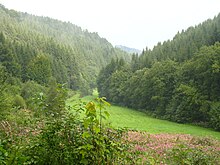Nahmerbach
| Nahmerbach | ||
|
Nahmerbach in the Brenscheid district |
||
| Data | ||
| Water code | DE : 276698 | |
| location | North Rhine-Westphalia , Germany | |
| River system | Rhine | |
| Drain over | Lenne → Ruhr → Rhine → North Sea | |
| source | At forest area 51 ° 15 ′ 59 ″ N , 7 ° 37 ′ 54 ″ E |
|
| Source height | approx. 446 m above sea level NN | |
| muzzle | In Hohenlimburg in the Lenne coordinates: 51 ° 20 ′ 43 " N , 7 ° 34 ′ 48" E 51 ° 20 ′ 43 " N , 7 ° 34 ′ 48" E |
|
| Mouth height | approx. 117 m above sea level NN | |
| Height difference | approx. 329 m | |
| Bottom slope | approx. 29 ‰ | |
| length | 11.5 km | |
| Catchment area | 25.948 km² | |
| Big cities | Hagen | |
| Small towns | Nachrodt-Wiblingwerde , Schalksmühle | |
|
Brenscheider grain mill |
||
The Nahmerbach or the Nahmer for short is an 11.54 km long orographically left tributary of the Lenne in North Rhine-Westphalia , Germany . The landscape of the upper Nahmer Valley is also known as Nahmer Switzerland .
course
According to the state survey office of North Rhine-Westphalia, the stream rises near the village of Waldstück, which belongs to Nachrodt-Wiblingwerde, at an altitude of 446 m above sea level. NN . On the German base map, however, another source stream bears the name Nahmerbach, which is located in the village of Sonnenscheid at 461 m above sea level. NN rises and flows into the former after 1.5 km.
The Nahmerbach flows predominantly in a north-northwest direction as a border brook of the communities Nachrodt-Wiblingwerde and Schalksmühle , flows through Hagen and then flows into Hagen-Hohenlimburg at an altitude of 117 m above sea level. NN from the left into the Lenne. On its 11.2 km long path, the stream runs through a height difference of 329 m, which corresponds to a mean bed gradient of 29.4 ‰.
At the Nahmerbach there are numerous former water mills, hammer mills and, in the lower reaches, other industrial plants of the Hohenlimburg cold rolling industry. The buildings that are significant in terms of industrial history include the former castle brewery, the Lennewehr, the former roller, the Giebel rolling mill , the administration building of a former copper hammer, a former factory owner's house, the Selbach hammer , the Brenscheider grain mill and the Brenscheider oil mill .
Cold rolling industry in the Nahmertal
In the 17th century, an important textile industry established itself in the Wupper valley ; Their so-called Barmer articles - braids , ribbons , threads , fabrics, clothing , etc. - were exported all over the world. But not only the raw materials had to be imported to the Wupper , also the necessary machines such as looms and spinning machines . From the beginning of the 19th century, metal wire was an essential part of the machines .
In order to meet the growing demand for wire for the machines of the Wuppertal textile industry, wire drawing shops settled in Nahmerbach and from 1850 onwards, with the advent of crinoline and corset fashion , all cold rolling plants were established . Large quantities of high-quality steel strips and special wires were produced which, in addition to the textile industry, were also used for the manufacture of bicycles and typewriters .
In the lower Nahmerbachtal to Hohenlimburg there was one of the highest densities of this branch of industry in the region towards the end of the 19th century, the Hohenlimburg small railway running parallel to the brook ensured the connection to the railway network. A few companies still produce here today despite the massive structural change . This includes the company CD Wälzholz in the company , in front of whose works a locomotive of the Hohenlimburg small railway is on display. The company JP Hüseken & Comp in Obernahmer and the Nimmertal owned a factory owner's house from the years before 1810, which is now used as a residential building. Architecturally noteworthy is the three-part facade of the Giebel company, which was built in 1925 . These industrial monuments are part of the Route of Industrial Culture .
Koenig Lake
At the Lame Hasen there was a reservoir , the so-called Koenig-See , which is named after the industrialist Heinrich Koenig. The pond was created to store the cooling water for the WURAG company . In the summer months, the lake used to be a popular destination. In 1995 the pond was drained when the Krupp plant closed.
In the upper reaches of the Nahmerbach there are now a few ponds that are used for trout breeding.
Backwaters
- Mesekendahler Bach
- Brenscheider Bach
- Kamer Siepen
- Westerbach
- Biekmannssiepen
- Hemecke
- Germes Siepen
- Langenscheider Bach
- Hobracker Bach
- Little Heimke
- Stöckinghagener Bach
- Wiggenschlader Bach
- Wörder Bach
- Mühlenschlader Bach
- Nimmerbach
- Haardtbach
- Mountain stream
Individual evidence
- ↑ a b German basic map 1: 5000
- ↑ a b Topographical Information Management, Cologne District Government, Department GEObasis NRW ( Notes )
- ↑ Heimatverein Hohenlimburg ( page no longer available , search in web archives ) Info: The link was automatically marked as defective. Please check the link according to the instructions and then remove this notice. (PDF; 52 kB)
Web links
Description of this sight on the route of industrial culture



